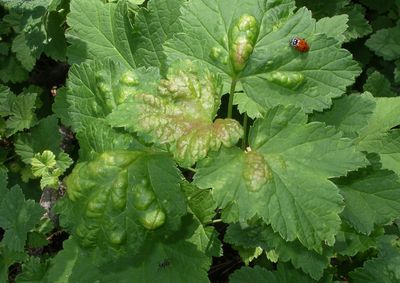Banner year for aphids and their trappings

Our cool spring has been perfect for aphids this year. As a result they are showing up on all kinds of perennials, shrubs and trees.
There are literally dozens of different kinds of aphids, many of which prey on particular plants. They are generally about a sixteenth- to an eighth-inch long, in colors of green, brown, purple, red and black. Some are shiny while others have a waxy, cottony covering. All of them have long thin legs, sucking mouth parts, long antennas, a pear-shaped body and a pair of tiny tubes that project from the bug’s posterior. They are most often found on the underside of the leaves, where they tap directly into a plant vein to suck sap.
Aphids produce several generations a year. They overwinter as eggs on the trunks, branches and roots of host plants. The overwintering eggs hatch as females that can produce live young in less than 10 days. As the colony grows, winged aphids are produced and these fly to a new plant where they begin a new cycle.
Aphid damage rarely kills plants, but they extensively distort foliage and create a sticky mess of honeydew that drips onto anything under the tree. The honeydew draws ants that often tend the aphids to harvest the sweet solution. The honeydew also spawns a sooty, black mold that just adds to the mess.
Controlling aphids is an exercise in persistence and patience. Choose varieties of plants that are resistant to aphids. This may take some experimentation and research. Use a hard stream of water to blast the bugs off plants you can easily reach. This interrupts their living patterns enough to slow them down.
Encourage predator insects that will seek out aphids for dinner. The aphid population will build to a certain level and then the lady beetles, lacewing larvae and hover fly larvae will move in and lay eggs or eat the aphids on the infested plants. Learn to recognize these bugs and watch for them on your plants.
Insecticidal soaps applied as a spray attack the soft exposed tissues of the aphids, killing by contact. Be sure to get the spray to the underside of the leaves where the aphids are hiding. A caution however; insecticidal soaps will also kill the predatory insects.
Systemic insecticides applied to the plant are picked up by the plant’s vascular system and transferred to the aphids when they suck the sap. The advantage of systemics is that they will protect the plant for a period of time.
Controlling aphids in large trees you can’t easily reach may be a job for a professional with the right equipment, systemic chemicals not available to the homeowner and timing. Because it takes about four months for a large tree to move the chemical to the top of the canopy, controls must be done in August or September or very early in the spring. In other words, if the aphids are already in the trees, it’s probably too late to treat effectively.